- Release Notes and Announcements
- Release Notes
- Announcements
- qGPU Service Adjustment
- Version Upgrade of Master Add-On of TKE Managed Cluster
- Upgrading tke-monitor-agent
- Discontinuing TKE API 2.0
- Instructions on Cluster Resource Quota Adjustment
- Discontinuing Kubernetes v1.14 and Earlier Versions
- Deactivation of Scaling Group Feature
- Notice on TPS Discontinuation on May 16, 2022 at 10:00 (UTC +8)
- Basic Monitoring Architecture Upgrade
- Starting Charging on Managed Clusters
- Instructions on Stopping Delivering the Kubeconfig File to Nodes
- Security Vulnerability Fix Description
- Release Notes
- Product Introduction
- Purchase Guide
- Quick Start
- TKE General Cluster Guide
- TKE General Cluster Overview
- Purchase a TKE General Cluster
- High-risk Operations of Container Service
- Deploying Containerized Applications in the Cloud
- Kubernetes API Operation Guide
- Open Source Components
- Permission Management
- Cluster Management
- Cluster Overview
- Cluster Hosting Modes Introduction
- Cluster Lifecycle
- Creating a Cluster
- Deleting a Cluster
- Cluster Scaling
- Changing the Cluster Operating System
- Connecting to a Cluster
- Upgrading a Cluster
- Enabling IPVS for a Cluster
- Enabling GPU Scheduling for a Cluster
- Custom Kubernetes Component Launch Parameters
- Using KMS for Kubernetes Data Source Encryption
- Images
- Worker node introduction
- Normal Node Management
- Native Node Management
- Overview
- Purchasing Native Nodes
- Lifecycle of a Native Node
- Native Node Parameters
- Creating Native Nodes
- Deleting Native Nodes
- Self-Heal Rules
- Declarative Operation Practice
- Native Node Scaling
- In-place Pod Configuration Adjustment
- Enabling SSH Key Login for a Native Node
- Management Parameters
- Enabling Public Network Access for a Native Node
- Supernode management
- Registered Node Management
- GPU Share
- Kubernetes Object Management
- Overview
- Namespace
- Workload
- Deployment Management
- StatefulSet Management
- DaemonSet Management
- Job Management
- CronJob Management
- Setting the Resource Limit of Workload
- Setting the Scheduling Rule for a Workload
- Setting the Health Check for a Workload
- Setting the Run Command and Parameter for a Workload
- Using a Container Image in a TCR Enterprise Instance to Create a Workload
- Auto Scaling
- Configuration
- Register node management
- Service Management
- Ingress Management
- Storage Management
- Application and Add-On Feature Management Description
- Add-On Management
- Add-on Overview
- Add-On Lifecycle Management
- CBS-CSI Description
- UserGroupAccessControl
- COS-CSI
- CFS-CSI
- P2P
- OOMGuard
- TCR Introduction
- TCR Hosts Updater
- DNSAutoscaler
- NodeProblemDetectorPlus Add-on
- NodeLocalDNSCache
- Network Policy
- DynamicScheduler
- DeScheduler
- Nginx-ingress
- HPC
- Description of tke-monitor-agent
- GPU-Manager Add-on
- CFSTURBO-CSI
- tke-log-agent
- Helm Application
- Application Market
- Network Management
- Container Network Overview
- GlobalRouter Mode
- VPC-CNI Mode
- VPC-CNI Mode
- Multiple Pods with Shared ENI Mode
- Pods with Exclusive ENI Mode
- Static IP Address Mode Instructions
- Non-static IP Address Mode Instructions
- Interconnection Between VPC-CNI and Other Cloud Resources/IDC Resources
- Security Group of VPC-CNI Mode
- Instructions on Binding an EIP to a Pod
- VPC-CNI Component Description
- Limits on the Number of Pods in VPC-CNI Mode
- Cilium-Overlay Mode
- OPS Center
- Log Management
- Backup Center
- Cloud Native Monitoring
- Remote Terminals
- TKE Serverless Cluster Guide
- TKE Edge Cluster Guide
- TKE Registered Cluster Guide
- TKE Container Instance Guide
- Cloud Native Service Guide
- Best Practices
- Cluster
- Cluster Migration
- Serverless Cluster
- Edge Cluster
- Security
- Service Deployment
- Hybrid Cloud
- Network
- DNS
- Using Network Policy for Network Access Control
- Deploying NGINX Ingress on TKE
- Nginx Ingress High-Concurrency Practices
- Nginx Ingress Best Practices
- Limiting the bandwidth on pods in TKE
- Directly connecting TKE to the CLB of pods based on the ENI
- Use CLB-Pod Direct Connection on TKE
- Obtaining the Real Client Source IP in TKE
- Using Traefik Ingress in TKE
- Release
- Logs
- Monitoring
- OPS
- Removing and Re-adding Nodes from and to Cluster
- Using Ansible to Batch Operate TKE Nodes
- Using Cluster Audit for Troubleshooting
- Renewing a TKE Ingress Certificate
- Using cert-manager to Issue Free Certificates
- Using cert-manager to Issue Free Certificate for DNSPod Domain Name
- Using the TKE NPDPlus Plug-In to Enhance the Self-Healing Capability of Nodes
- Using kubecm to Manage Multiple Clusters kubeconfig
- Quick Troubleshooting Using TKE Audit and Event Services
- Customizing RBAC Authorization in TKE
- Clearing De-registered Tencent Cloud Account Resources
- Terraform
- DevOps
- Auto Scaling
- Cluster Auto Scaling Practices
- Using tke-autoscaling-placeholder to Implement Auto Scaling in Seconds
- Installing metrics-server on TKE
- Using Custom Metrics for Auto Scaling in TKE
- Utilizing HPA to Auto Scale Businesses on TKE
- Using VPA to Realize Pod Scaling up and Scaling down in TKE
- Adjusting HPA Scaling Sensitivity Based on Different Business Scenarios
- Storage
- Containerization
- Microservice
- Cost Management
- Fault Handling
- Disk Full
- High Workload
- Memory Fragmentation
- Cluster DNS Troubleshooting
- Cluster kube-proxy Troubleshooting
- Cluster API Server Inaccessibility Troubleshooting
- Service and Ingress Inaccessibility Troubleshooting
- Troubleshooting for Pod Network Inaccessibility
- Pod Status Exception and Handling
- Authorizing Tencent Cloud OPS Team for Troubleshooting
- Engel Ingres appears in Connechtin Reverside
- CLB Loopback
- CLB Ingress Creation Error
- API Documentation
- History
- Introduction
- API Category
- Making API Requests
- Cluster APIs
- DescribeEncryptionStatus
- DisableEncryptionProtection
- EnableEncryptionProtection
- AcquireClusterAdminRole
- CreateClusterEndpoint
- CreateClusterEndpointVip
- DeleteCluster
- DeleteClusterEndpoint
- DeleteClusterEndpointVip
- DescribeAvailableClusterVersion
- DescribeClusterAuthenticationOptions
- DescribeClusterCommonNames
- DescribeClusterEndpointStatus
- DescribeClusterEndpointVipStatus
- DescribeClusterEndpoints
- DescribeClusterKubeconfig
- DescribeClusterLevelAttribute
- DescribeClusterLevelChangeRecords
- DescribeClusterSecurity
- DescribeClusterStatus
- DescribeClusters
- DescribeEdgeAvailableExtraArgs
- DescribeEdgeClusterExtraArgs
- DescribeResourceUsage
- DisableClusterDeletionProtection
- EnableClusterDeletionProtection
- GetClusterLevelPrice
- GetUpgradeInstanceProgress
- ModifyClusterAttribute
- ModifyClusterAuthenticationOptions
- ModifyClusterEndpointSP
- UpgradeClusterInstances
- CreateCluster
- UpdateClusterVersion
- UpdateClusterKubeconfig
- DescribeBackupStorageLocations
- DeleteBackupStorageLocation
- CreateBackupStorageLocation
- Add-on APIs
- Network APIs
- Node APIs
- Node Pool APIs
- TKE Edge Cluster APIs
- DescribeTKEEdgeScript
- DescribeTKEEdgeExternalKubeconfig
- DescribeTKEEdgeClusters
- DescribeTKEEdgeClusterStatus
- DescribeTKEEdgeClusterCredential
- DescribeEdgeClusterInstances
- DescribeEdgeCVMInstances
- DescribeECMInstances
- DescribeAvailableTKEEdgeVersion
- DeleteTKEEdgeCluster
- DeleteEdgeClusterInstances
- DeleteEdgeCVMInstances
- DeleteECMInstances
- CreateTKEEdgeCluster
- CreateECMInstances
- CheckEdgeClusterCIDR
- ForwardTKEEdgeApplicationRequestV3
- UninstallEdgeLogAgent
- InstallEdgeLogAgent
- DescribeEdgeLogSwitches
- CreateEdgeLogConfig
- CreateEdgeCVMInstances
- UpdateEdgeClusterVersion
- DescribeEdgeClusterUpgradeInfo
- Cloud Native Monitoring APIs
- Virtual node APIs
- Other APIs
- Scaling group APIs
- Data Types
- Error Codes
- API Mapping Guide
- TKE Insight
- TKE Scheduling
- FAQs
- Service Agreement
- Contact Us
- Purchase Channels
- Glossary
- User Guide(Old)
- Release Notes and Announcements
- Release Notes
- Announcements
- qGPU Service Adjustment
- Version Upgrade of Master Add-On of TKE Managed Cluster
- Upgrading tke-monitor-agent
- Discontinuing TKE API 2.0
- Instructions on Cluster Resource Quota Adjustment
- Discontinuing Kubernetes v1.14 and Earlier Versions
- Deactivation of Scaling Group Feature
- Notice on TPS Discontinuation on May 16, 2022 at 10:00 (UTC +8)
- Basic Monitoring Architecture Upgrade
- Starting Charging on Managed Clusters
- Instructions on Stopping Delivering the Kubeconfig File to Nodes
- Security Vulnerability Fix Description
- Release Notes
- Product Introduction
- Purchase Guide
- Quick Start
- TKE General Cluster Guide
- TKE General Cluster Overview
- Purchase a TKE General Cluster
- High-risk Operations of Container Service
- Deploying Containerized Applications in the Cloud
- Kubernetes API Operation Guide
- Open Source Components
- Permission Management
- Cluster Management
- Cluster Overview
- Cluster Hosting Modes Introduction
- Cluster Lifecycle
- Creating a Cluster
- Deleting a Cluster
- Cluster Scaling
- Changing the Cluster Operating System
- Connecting to a Cluster
- Upgrading a Cluster
- Enabling IPVS for a Cluster
- Enabling GPU Scheduling for a Cluster
- Custom Kubernetes Component Launch Parameters
- Using KMS for Kubernetes Data Source Encryption
- Images
- Worker node introduction
- Normal Node Management
- Native Node Management
- Overview
- Purchasing Native Nodes
- Lifecycle of a Native Node
- Native Node Parameters
- Creating Native Nodes
- Deleting Native Nodes
- Self-Heal Rules
- Declarative Operation Practice
- Native Node Scaling
- In-place Pod Configuration Adjustment
- Enabling SSH Key Login for a Native Node
- Management Parameters
- Enabling Public Network Access for a Native Node
- Supernode management
- Registered Node Management
- GPU Share
- Kubernetes Object Management
- Overview
- Namespace
- Workload
- Deployment Management
- StatefulSet Management
- DaemonSet Management
- Job Management
- CronJob Management
- Setting the Resource Limit of Workload
- Setting the Scheduling Rule for a Workload
- Setting the Health Check for a Workload
- Setting the Run Command and Parameter for a Workload
- Using a Container Image in a TCR Enterprise Instance to Create a Workload
- Auto Scaling
- Configuration
- Register node management
- Service Management
- Ingress Management
- Storage Management
- Application and Add-On Feature Management Description
- Add-On Management
- Add-on Overview
- Add-On Lifecycle Management
- CBS-CSI Description
- UserGroupAccessControl
- COS-CSI
- CFS-CSI
- P2P
- OOMGuard
- TCR Introduction
- TCR Hosts Updater
- DNSAutoscaler
- NodeProblemDetectorPlus Add-on
- NodeLocalDNSCache
- Network Policy
- DynamicScheduler
- DeScheduler
- Nginx-ingress
- HPC
- Description of tke-monitor-agent
- GPU-Manager Add-on
- CFSTURBO-CSI
- tke-log-agent
- Helm Application
- Application Market
- Network Management
- Container Network Overview
- GlobalRouter Mode
- VPC-CNI Mode
- VPC-CNI Mode
- Multiple Pods with Shared ENI Mode
- Pods with Exclusive ENI Mode
- Static IP Address Mode Instructions
- Non-static IP Address Mode Instructions
- Interconnection Between VPC-CNI and Other Cloud Resources/IDC Resources
- Security Group of VPC-CNI Mode
- Instructions on Binding an EIP to a Pod
- VPC-CNI Component Description
- Limits on the Number of Pods in VPC-CNI Mode
- Cilium-Overlay Mode
- OPS Center
- Log Management
- Backup Center
- Cloud Native Monitoring
- Remote Terminals
- TKE Serverless Cluster Guide
- TKE Edge Cluster Guide
- TKE Registered Cluster Guide
- TKE Container Instance Guide
- Cloud Native Service Guide
- Best Practices
- Cluster
- Cluster Migration
- Serverless Cluster
- Edge Cluster
- Security
- Service Deployment
- Hybrid Cloud
- Network
- DNS
- Using Network Policy for Network Access Control
- Deploying NGINX Ingress on TKE
- Nginx Ingress High-Concurrency Practices
- Nginx Ingress Best Practices
- Limiting the bandwidth on pods in TKE
- Directly connecting TKE to the CLB of pods based on the ENI
- Use CLB-Pod Direct Connection on TKE
- Obtaining the Real Client Source IP in TKE
- Using Traefik Ingress in TKE
- Release
- Logs
- Monitoring
- OPS
- Removing and Re-adding Nodes from and to Cluster
- Using Ansible to Batch Operate TKE Nodes
- Using Cluster Audit for Troubleshooting
- Renewing a TKE Ingress Certificate
- Using cert-manager to Issue Free Certificates
- Using cert-manager to Issue Free Certificate for DNSPod Domain Name
- Using the TKE NPDPlus Plug-In to Enhance the Self-Healing Capability of Nodes
- Using kubecm to Manage Multiple Clusters kubeconfig
- Quick Troubleshooting Using TKE Audit and Event Services
- Customizing RBAC Authorization in TKE
- Clearing De-registered Tencent Cloud Account Resources
- Terraform
- DevOps
- Auto Scaling
- Cluster Auto Scaling Practices
- Using tke-autoscaling-placeholder to Implement Auto Scaling in Seconds
- Installing metrics-server on TKE
- Using Custom Metrics for Auto Scaling in TKE
- Utilizing HPA to Auto Scale Businesses on TKE
- Using VPA to Realize Pod Scaling up and Scaling down in TKE
- Adjusting HPA Scaling Sensitivity Based on Different Business Scenarios
- Storage
- Containerization
- Microservice
- Cost Management
- Fault Handling
- Disk Full
- High Workload
- Memory Fragmentation
- Cluster DNS Troubleshooting
- Cluster kube-proxy Troubleshooting
- Cluster API Server Inaccessibility Troubleshooting
- Service and Ingress Inaccessibility Troubleshooting
- Troubleshooting for Pod Network Inaccessibility
- Pod Status Exception and Handling
- Authorizing Tencent Cloud OPS Team for Troubleshooting
- Engel Ingres appears in Connechtin Reverside
- CLB Loopback
- CLB Ingress Creation Error
- API Documentation
- History
- Introduction
- API Category
- Making API Requests
- Cluster APIs
- DescribeEncryptionStatus
- DisableEncryptionProtection
- EnableEncryptionProtection
- AcquireClusterAdminRole
- CreateClusterEndpoint
- CreateClusterEndpointVip
- DeleteCluster
- DeleteClusterEndpoint
- DeleteClusterEndpointVip
- DescribeAvailableClusterVersion
- DescribeClusterAuthenticationOptions
- DescribeClusterCommonNames
- DescribeClusterEndpointStatus
- DescribeClusterEndpointVipStatus
- DescribeClusterEndpoints
- DescribeClusterKubeconfig
- DescribeClusterLevelAttribute
- DescribeClusterLevelChangeRecords
- DescribeClusterSecurity
- DescribeClusterStatus
- DescribeClusters
- DescribeEdgeAvailableExtraArgs
- DescribeEdgeClusterExtraArgs
- DescribeResourceUsage
- DisableClusterDeletionProtection
- EnableClusterDeletionProtection
- GetClusterLevelPrice
- GetUpgradeInstanceProgress
- ModifyClusterAttribute
- ModifyClusterAuthenticationOptions
- ModifyClusterEndpointSP
- UpgradeClusterInstances
- CreateCluster
- UpdateClusterVersion
- UpdateClusterKubeconfig
- DescribeBackupStorageLocations
- DeleteBackupStorageLocation
- CreateBackupStorageLocation
- Add-on APIs
- Network APIs
- Node APIs
- Node Pool APIs
- TKE Edge Cluster APIs
- DescribeTKEEdgeScript
- DescribeTKEEdgeExternalKubeconfig
- DescribeTKEEdgeClusters
- DescribeTKEEdgeClusterStatus
- DescribeTKEEdgeClusterCredential
- DescribeEdgeClusterInstances
- DescribeEdgeCVMInstances
- DescribeECMInstances
- DescribeAvailableTKEEdgeVersion
- DeleteTKEEdgeCluster
- DeleteEdgeClusterInstances
- DeleteEdgeCVMInstances
- DeleteECMInstances
- CreateTKEEdgeCluster
- CreateECMInstances
- CheckEdgeClusterCIDR
- ForwardTKEEdgeApplicationRequestV3
- UninstallEdgeLogAgent
- InstallEdgeLogAgent
- DescribeEdgeLogSwitches
- CreateEdgeLogConfig
- CreateEdgeCVMInstances
- UpdateEdgeClusterVersion
- DescribeEdgeClusterUpgradeInfo
- Cloud Native Monitoring APIs
- Virtual node APIs
- Other APIs
- Scaling group APIs
- Data Types
- Error Codes
- API Mapping Guide
- TKE Insight
- TKE Scheduling
- FAQs
- Service Agreement
- Contact Us
- Purchase Channels
- Glossary
- User Guide(Old)
Overview
Tencent Kubernetes Engine (TKE) allows you to create PersistentVolumes (PVs) and PersistentVolumeClaims (PVCs) and use existing PVCs when creating workloads and adding volumes so that you can manage a file system by using the PVs and PVCs.
Note:Different regions support different file storage capabilities. You need to select a region based on your requirement. For more information, see Storage Class and Performance Specification.
Preparations
Installing the CFS add-on
Note:If your cluster has been installed with the CFS-CSI add-on, skip this step.
- Log in to the TKE console.
- In the left sidebar, click Cluster to go to the Cluster Management page.
- Click the ID of the cluster for which you want to create an add-on to go to the Cluster Details page.
- Select Add-On Management > Create to go to Create an Add-On page.
- On the Create Add-on page, select CFS and click Done.
Creating a StorageClass in the console
To statically create a PV of the file storage type, you need to bind an available StorageClass of the same type. For more information, see Creating a StorageClass via the Console.
Creating a CFS file system
- Log in to the CFS console and go to the File System page.
- Click Create. Select the file system type first: Standard Storage or Performance Storage. The supported types vary by AZ. For more information, see Available Regions. Then, configure the detailed settings:
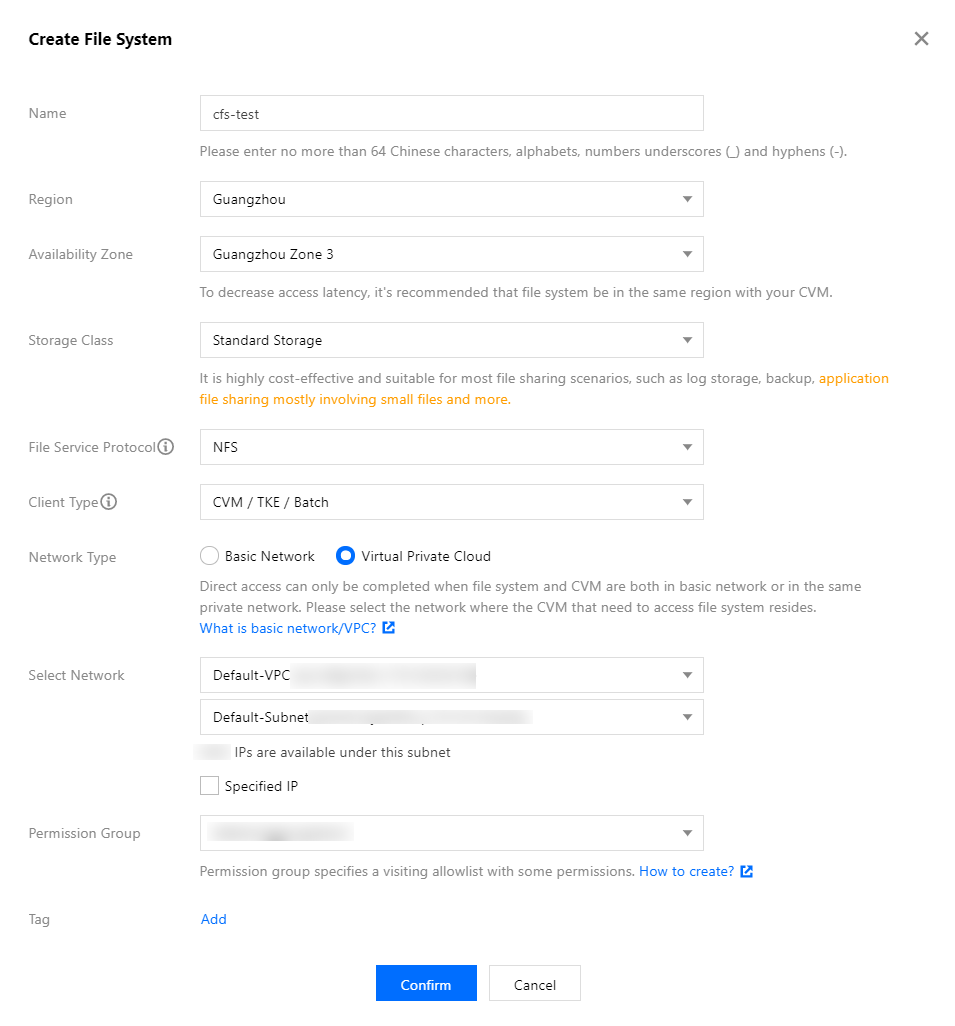
- Name: set a custom name. This document uses
cfs-testas an example. - *Region: select a region in which to create the file system and ensure that the file system and the cluster are in the same region.
- Availability Zone: select an availability zone in which to create the file system.
- File Service Protocol: select a protocol type for the file system. Valid values include NFS and CIFS/SMB.
- NFS: better suited to Linux and Unix clients.
- CIFS/SMB: better suited to Windows clients.
- Data Source: you can create a file system from a snapshot.
- Select Network: select a network to ensure that the file system and the cluster that uses the file system are in the same VPC.
- Permission Group: each file system must be bound to a permission group. The permission group specifies an allowlist that can access the file system and lists the read and write permissions.
- Tag:
- If you have a tag, you can add it to the file system.
- If you do not have a tag, log in to the Tag console to create the required tag, and then bind the tag to the file system. You can also add a tag to the file system after the file system is created.
- Name: set a custom name. This document uses
- Click Buy Now and wait for the creation to succeed.
Getting the file system subdirectory
- On the File System page, click the ID of the file system for which you want to obtain the destination subdirectory. The details page of the file system appears.
- Select the Mount Point Info tab and obtain the subdirectory
/subfolderof this file system from Mount to Linux as shown below:
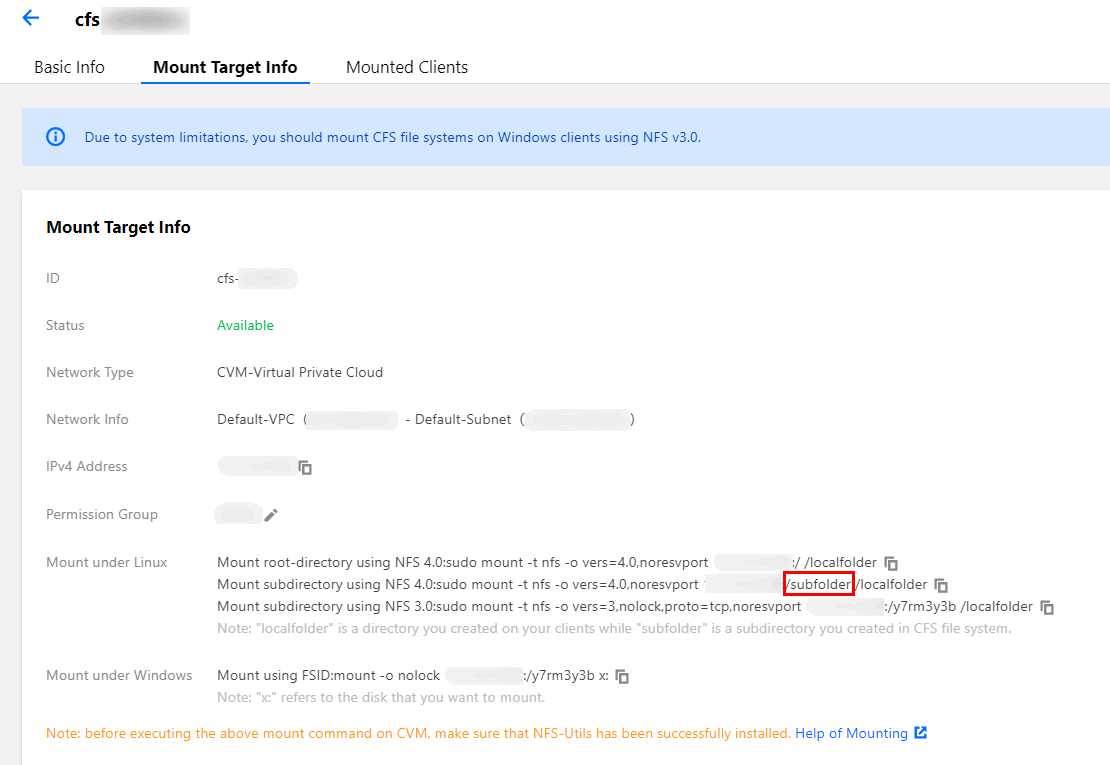
localfolder: indicates the local directory that you created.subfolder: it indicates a subdirectory that you created in the CFS file system. The subdirectory of the file system is/subfolder.
Getting the file system FSID
Note:For better stability, when using the NFSv3 protocol to mount, you need to specify the FSID of the file system to be mounted.
- In the CFS console, click the ID of the file system for which you want to obtain the FSID. The details page of the file system appears.
- Select the Mount Target Info tab and get the file system FSID next to Mount to Linux such as
a43qadklas shown below:
Directions
Creating a PV statically
Note:A statically created PV is suitable for scenarios where file storage already contains data and is used in a cluster.
- Log in to the TKE console and select Clusters on the left sidebar.
- On the Cluster Management page, select the ID of the cluster where the PV needs to be created. The cluster management page of the PV to create appears.
- Choose Storage > PersistentVolume in the left sidebar to go to the PersistentVolume page, as shown in the following figure.
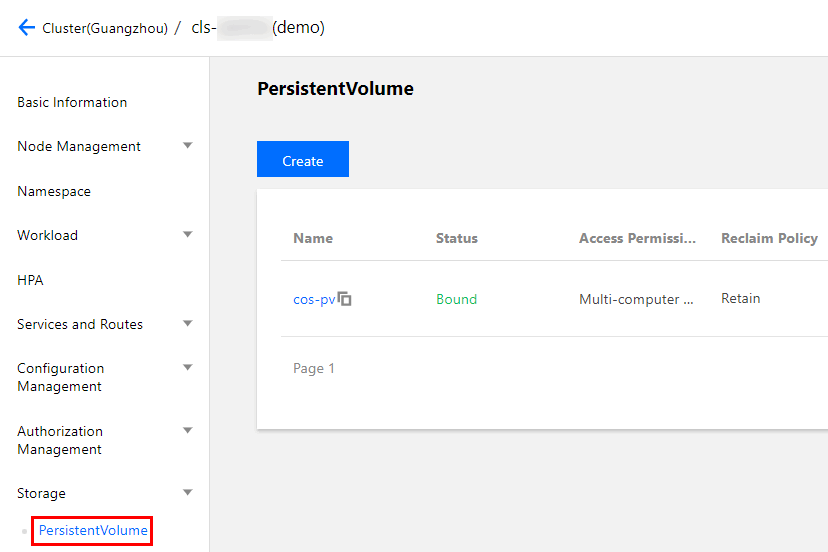
- Click Create to go to the Create PersistentVolume page, where you can set PV parameters as required as shown below:
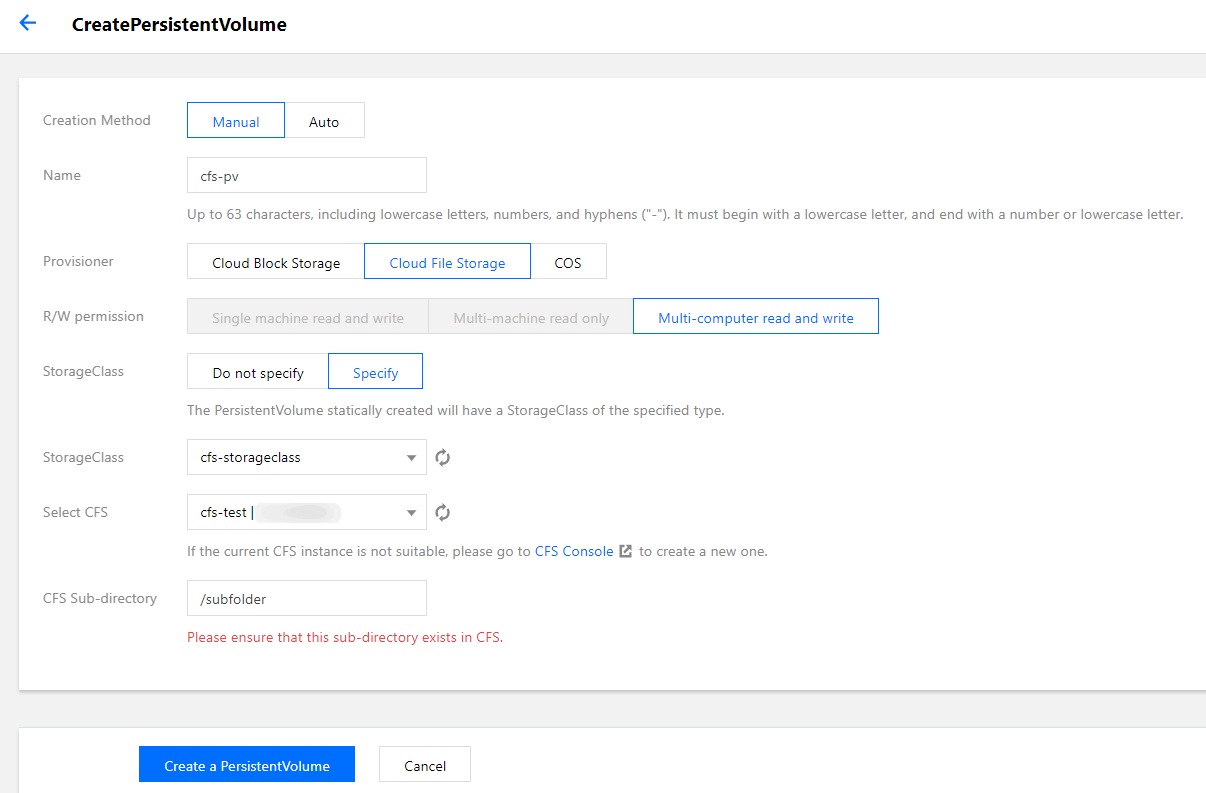
- Creation Method: select Manual.
- Name: set a custom name. This document uses
cfs-pvas an example. - Provisioner: select Cloud File Storage.
- R/W permission: CFS only supports multi-server read and write.
- StorageClass: select a StorageClass as required. This document uses
cfs-storageclass, which you created in the step of Creating a StorageClass via the console, as an example.Note:- The PVC and PV will be bound to the same StorageClass.
- If you do not specify a StorageClass, the value of
StorageClassfor the corresponding PV is empty, and the value of thestorageClassNamefield in the corresponding YAML file is a null string.
- Select CFS: ensure that the CFS and the current cluster are in the same VPC. This document uses
cfs-test, which you created in the step of Creating CFS, as an example. - CFS Subfolder: enter the file system subdirectory that you obtained in the step of Obtaining the file system subdirectory. This document uses
/subfolderas an example.
- Click Create PersistentVolume to complete the creation.
Creating a PVC
- On the target cluster details page, choose Storage > PersistentVolumeClaim in the left sidebar to go to the PersistentVolumeClaim page, as shown in the following figure.

- Click Create to go to the Create PersistentVolumeClaim page, where you can set key PVC parameters as required, as shown in the following figure.
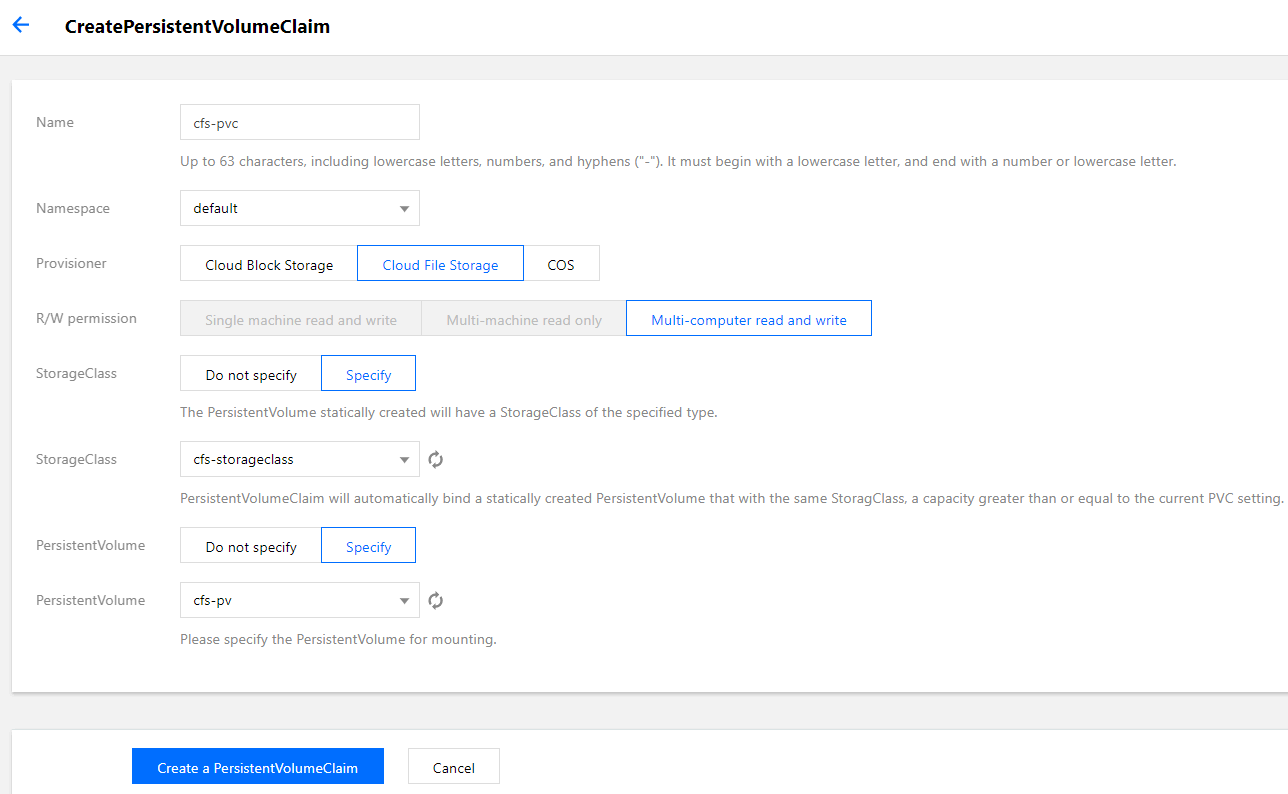
- Name: set a custom name. This document uses
cfs-pvcas an example. - Namespace: select default.
- Provisioner: select Cloud File Storage.
- R/W permission: CFS only supports multi-server read and write.
- StorageClass: select a StorageClass as required. This document uses
cfs-storageclass, which you created in the step of Creating a StorageClass via the console, as an example.Note:- The PVC and PV will be bound to the same StorageClass.
- If you do not specify a StorageClass, the value of
StorageClassfor the corresponding PVC is empty, and the value of thestorageClassNamefield in the corresponding YAML file is a null string.
- PersistVolume: specify a PersistentVolume as required. This document uses the
cfs-pvcreated in the Creating a PV statically step as an example.Note:- Only PVs in the specified StorageClass and in the Available or Released statuses can be selected. If no PV in the current cluster meets the conditions, select Do not specify in Specify PersistVolume.
- If the status of the selected PV is Released, you need to manually delete the
claimReffield in the corresponding YAML configuration file of the PV so that the PV can be successfully bound with the PVC. For more information, see PV and PVC Binding Rules.
- Name: set a custom name. This document uses
- Click Create PersistentVolumeClaim to complete the creation process.
Creating a workload to use a PVC volume
Note:This step creates a Deployment workload as an example.
- On the Cluster Management page, select the target cluster ID to go to the Deployment page of the cluster for which the workload needs to be deployed.
- Click Create to go to the Create Workload page. For more information on how to create a workload, see Creating a Deployment. Then, mount a volume as required, as shown in the following figure.
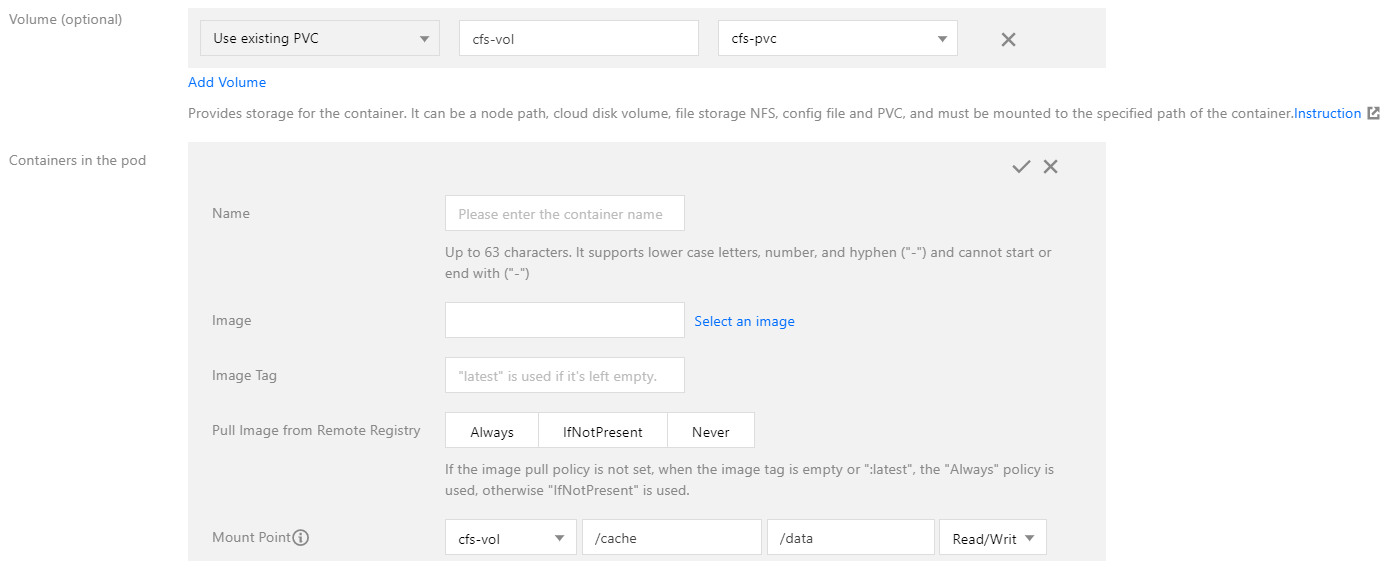
- Volume (optional):
- Mount method: select Use existing PVC.
- Volume name: set a custom name. This document uses
cfs-volas an example. - Select PVC: select
cfs-pvc, which you created in the step of Creating a PVC.
- Containers in the Pod: click Add Mount Target to set a mount target.
- Volume: select the volume
cfs-volthat you added in this step. - Destination Path: enter a destination path. This document uses
/cacheas an example. - Sub-path: mount only a sub-path or a single file in the selected volume, such as
/dataor/test.txt.
- Volume: select the volume
- Volume (optional):
- Click Create Workload to complete the process.
Note:
If you use the PVC mount method of CFS, the volume can be mounted to multiple nodes.
Kubectl operation instructions
Creating a PV
apiVersion: v1
kind: PersistentVolume
metadata:
name: cfs
spec:
accessModes:
- ReadWriteMany
capacity:
storage: 10Gi
csi:
driver: com.tencent.cloud.csi.cfs
volumeAttributes:
fsid: XXXXXX
host: 192.168.XX.XX
path: /
vers: "3"
volumeHandle: cfs
persistentVolumeReclaimPolicy: Retain
storageClassName: XXX
volumeMode: Filesystem
| Parameter | Required | Description |
|---|---|---|
| fsid | Yes | The file system's FSID (rather than ID), which can be viewed in the mount target information of the file system. |
| host | Yes | The file system's IP address, which can be viewed in the mount target information of the file system. |
| path | Yes | A subdirectory of the file system. After mounting, the workload will not be able to access the upper-level directory of this subdirectory. |
| vers | Yes | The version of the protocol used by the add-on to connect to the file system. Currently supported versions are "3" and "4". |
Note:If you specify the protocol version as
vers: "3"in the YAML file of the static PV, you also need to specify the FSID of the file system to be mounted (see Getting the file system FSID); otherwise, the mount will fail.vers: "4"does not require the FSID.

 Ya
Ya
 Tidak
Tidak
Apakah halaman ini membantu?